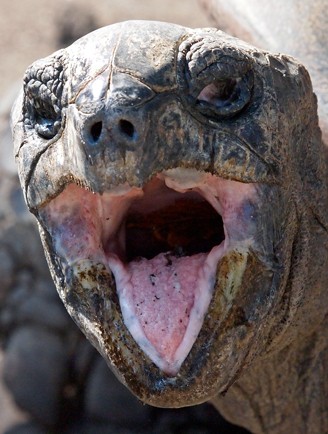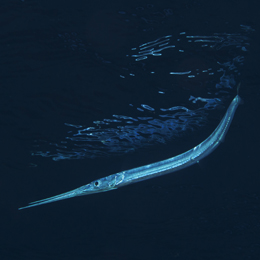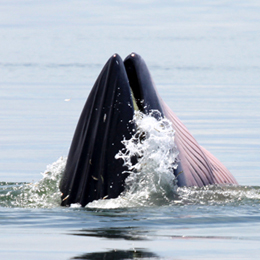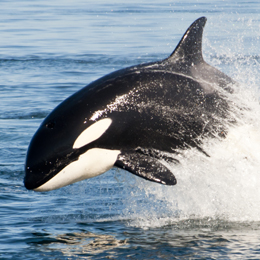Physical Description
The Aldabra Tortoise, known for its sheer size, is a massive creature that lives a long life, reaching an incredible age of 255 years according to the latest records.
The massive carapace or shell of the tortoise is like a heavily designed armor plate that protects its vulnerable body on the inside. This shell is typically shaped like a dome, a thick plate that secures the reptile's soft vital organs underneath.
The Aldabra Tortoise can easily be recognized by its massive carapace that measures between 90 - 120 cm (3 to 4 feet) in diameter and has a distinctive color which can either be dark brown or blackish-gray.
The legs of the Aldabra Tortoise are short and thick which enables it to bear the heavy weight of the shell. They are profusely covered in scales, an adaptation that enhances flexibility as it carries its massive weight around.
Featuring a thick tail and an extremely long neck, the Aldabra tortoise collects food from sources that are well above the ground. The long neck is a unique adaptation that can easily retract back into the shell and extends outwards as and when required.
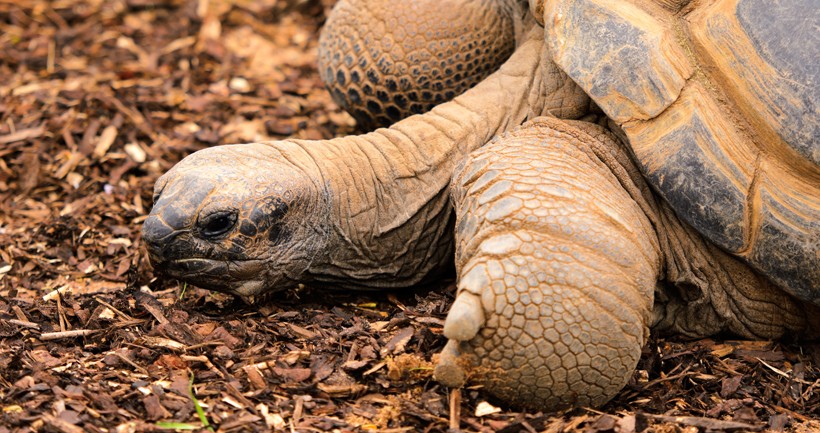
Aldabra Tortoise, islands of the Aldabra Atoll (Seychelles)
?
Image credits: Stephen Meese/Shutterstock
Size and Life Span
The sheer magnitude of the Aldabra tortoise’s size makes it highly conspicuous. The massive girth of this tortoise is a result of its huge exterior covering, the carapace.
In an adult male Aldabra, the shell can grow to an impressive length of around 121.9 cm (4 feet), whereas, in an adult female, which is slightly smaller, it can grow up to 91 cm (3 feet). While a mature male tortoise weighs around 250 kg (551 lbs) a mature female Aldabra can weigh up to 160 kg (340 lbs).
It is postulated that the Aldabra Tortoise has the longest life span among all other living animals. Although no specific documentation is available to corroborate this but it is believed that they can easily survive for more than a 100 years. There have been reports of an Aldabra tortoise having a lifespan of 255 years, however, this particular species was bred in captivity.
The long life span of the Aldabra Tortoise generally is a condition because of which the animal lives a solitary life and retires in an isolated habitat, where its natural predators are mostly absent.
There are four subspecies that are recognized currently
- A.g.gigantea – from the island of Aldabra in the Seychelles.
- A.g.arnoldi – from the island of Mahé in the Seychelles.
- A.g.daudinii – from the island of Mahé in the Seychelles, extinct since mid eighteen hundred.
- A.g.hololissa – from the islands of Silhouette, Praslin, Cousine, Round, Mahé and Frégate in the Seychelles.
Anatomy and Characteristics
The Aldabra Tortoise is easily distinguishable by its massive exterior shell, shaped like a dome with a typical coloring that is either dark brown or blackish in appearance. Coupled with its impressive carapace, the Aldabra also features stocky, muscular and scaly legs that make up for its imposing appearance although the tortoise is known to be quite docile.
Found northeast of Madagascar, the Aldabra is a gentle creature that carries its weight on its round, nearly flat feet while walking on the sandy beaches in search of food. Its rudimentary ears and eyes situated on the sides of its head are of little help in its daily activities. The species also has a tail that is thicker and longer in the case of males.
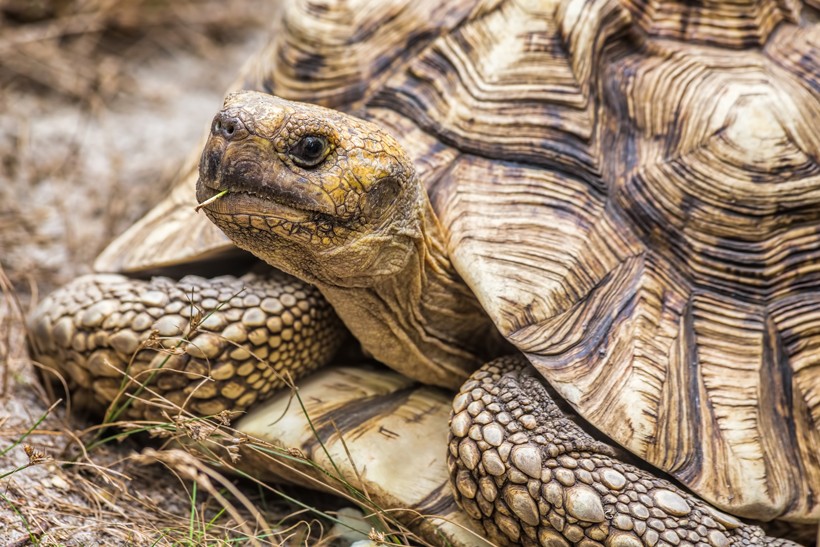
Typical dark brown color of the shell
?
Image credits: Stephen Bonk/Shutterstock
Touch: Contrary to what is believed prior, the Aldabra tortoise is very sensitive for touchment of its external sheath or skin.
Sight: Its eyes are situated on both sides of its head which offers a good vision. There is however still a debate about the sensitivity of its vision. The Aldabra Tortoise only uses its eyes to detect movement in the surroundings when it feels threatened.
Hearing: The Aldabra does not have a well-developed auditory organ. There are no external ears or hearing organs. Instead, the Aldabra tortoise exposes loose skin found behind its eyes and towards the posterior of its head.
Smell: This is primarily the only sense organ that is well developed and which the tortoise uses for various activities. The Aldabra uses its sense of smell to find food, search out likely spots breed or nest in find a suitable mate and of most importantly to smell the presence of likely predators.
Habitat
The Aldabra Tortoise flourishes in the scattered coral atoll islands of Seychelles, an island that is located in the western part of the Indian Ocean. The scrubs, mangrove swamps, coastal dunes and the flat grasslands also known as the platins, abound in this particular region and present the perfect grazing grounds to feed, flourish and carry on their slow-paced lifestyle.
The Aldabra tortoise spends most of its time searching for food, giving such grazing grounds a common term known as the ‘Tortoise Turf.’
Although it may seem that the Aldabra because of its massive size, is adapted to feeding on grubs available on the ground but there have been certain instances where the animal has been observed collecting food differently.
According to scientific observations, it has been found that the tortoise uses its long slender neck to pluck out succulent leaves. But the Aldabra is also adapted to moving on to more thinly populated, rocky areas in search for food. Besides its residual habitat that is rich in vegetation, this reptile can also be found near shaded areas where pools of water are present where it can cool off during the daytime heat.
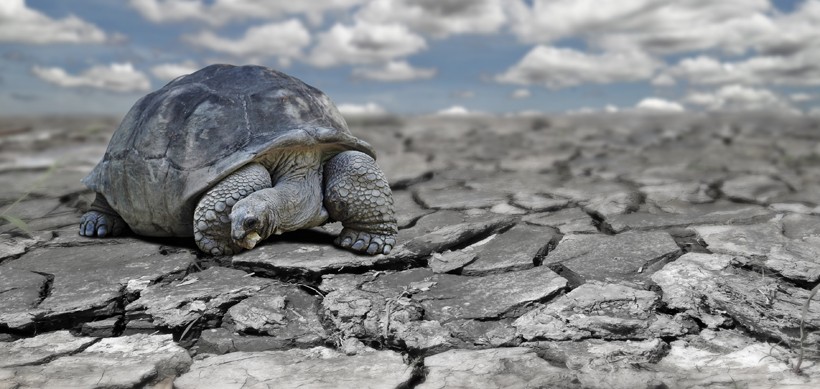
The Aldabra is also adapted to rocky areas in search for food
?
Image credits: Gwoeii/Shutterstock
Hunting
The Aldabra Tortoise is a herbivore and spends most of its time grazing on small grasses. With jaws that have the ability to devour different grasses separately, the Aldabra is most suitable on grassy plains. It has also been observed that the Aldabra eats carrion and invertebrates of smaller size.
This species is deceptively quick and can hide away in shallow water holes when it feels threatened. They may also be prone to eating feces if food is scarce.
The Aldabra Tortoise relies mostly on its keen sense of smell to track down food source, find a mating partner during a season and also to search for suitable nesting places. In captivity, the Aldabra tortoise can also eat fruits and vegetable balls (prepared by mixing different vegetables and pressing the mixture together in the form of a ball). The species will eat meat readily if it is available feeding on the carcasses of dead turtles.
Predators
The immense size of the adult Aldabra Tortoise and the isolated nature of its habitat ensure that it avoids any major threats from predators in the wild. But the smaller, young Aldabra tortoises are known to be more at risk. A young Aldabra is hunted by certain giant crab species that are usually present around its shelter and can easily break through its carapace.
Besides carnivorous crabs, the Aldabra Tortoise, especially the young ones, are predated upon by dogs and cats that have now invaded the pristine territory of the species due to continuous human interference.
Reproduction
The Aldabra Tortoise which is polygynandrous breeds between the months of February through May. The onset of sexual maturity in a female Aldabra is measured by size rather than the age of the tortoise. And it is roughly by the twenty-fifth year that a female tortoise can start to reproduce.
A female tortoise can lay about 9 to 25 eggs, showcasing an oviparous nature. After the mating is over, the female carries the eggs within her for an approximate period of 110 – 250 days (15 – 35 weeks). The eggs are rubbery in appearance and are laid in protective, dry hollow nests.
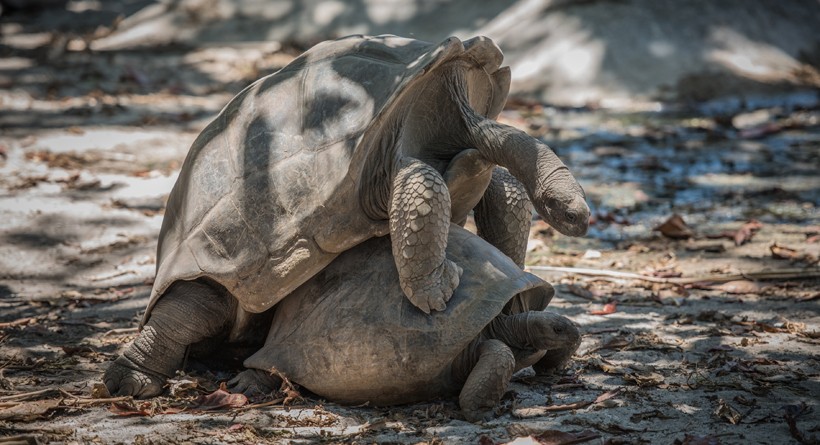
Aldabra tortoises mating
?
Image credits: javarman/Shutterstock
Only half of the laid eggs in the bundle turn out to be fertile giving birth to young tortoises.
The typical clutch size of a female Aldabra is around a dozen or two dozen eggs. This means that the number of offsprings born can be about 4 to 25, depending upon the number of fertile eggs. The incubation period that lasts for about 3 to 8 months varies according to prevalent climatic changes and environmental conditions.
During warmer conditions, the eggs can hatch earlier (110 days) while in colder climatic conditions hatching usually takes place after 250 days.
Between the months of late September through November end, the completely formed young Aldabra breaks out of its egg shell, digs its way out to the surface and starts to live an independent life. With the help of a nutrient sac, that is attached to it the tiny Aldabra, the tortoise survives for up to a week before gaining the ability to move and forage food on its own.
During such a period the baby tortoise increases its ability to move around and becomes stronger. After this period, the young Aldabra starts to eat food that has high protein content for better nutrient balance.

Newborn Aldabra Tortoises are called Hatchlings
?
Image credits: reptiles4all/Shutterstock
Life Cycle
The Aldabra Tortoise is considered to be one of the oldest species on earth. They usually live for more than 100 years.
The 182 year old Seychelles Giant tortoise, also known as Jonathan is the oldest living animal on earth that spends his days in the British overseas territory of St. Helena (the 255 year old Adwaita (born in 1750!) died in 2006).
The long life cycle of this species may be because of the slow growth rate and its isolated habitat where predation is least.
In young tortoises, the armor or the carapace is black and shiny. With each cycle of growth, a new tissue is added concentrically on its back which is marked by the presence of radial striations also known as growth rings on the shell. This helps determine the age of the tortoise.
Behavior
The Aldabra Tortoise is an early riser and is most active during the daytime. It starts its morning by looking for food in the open expanses of grasslands or searches for a dead/decaying matter in swampy marshes.
The species engages in a number of activities like mating, eating, sleeping, stretching, walking. While lumbering around, with their heads lowered, they closely crop the grass and other vegetation with their powerful jaws, leaving a tell-tale path where they have grazed upon. They can be found both individually or in herds where plenty of food is present.
In the wild, the Aldabra have been observed to stand on their stocky hind legs and use their feet for digging into burrows while searching for food.
As the daytime temperature rises, the Aldabra subsides into burrows underground or rests under shady bushes or in swamps to escape the heat. The Aldabra Tortoise is quite indifferent to human presence, continuing with its normal activities. This rather nonchalant behavior of the Aldabra sometimes becomes its downfall as it allows predators, especially humans, to approach it without showing any sign of fight or flight.
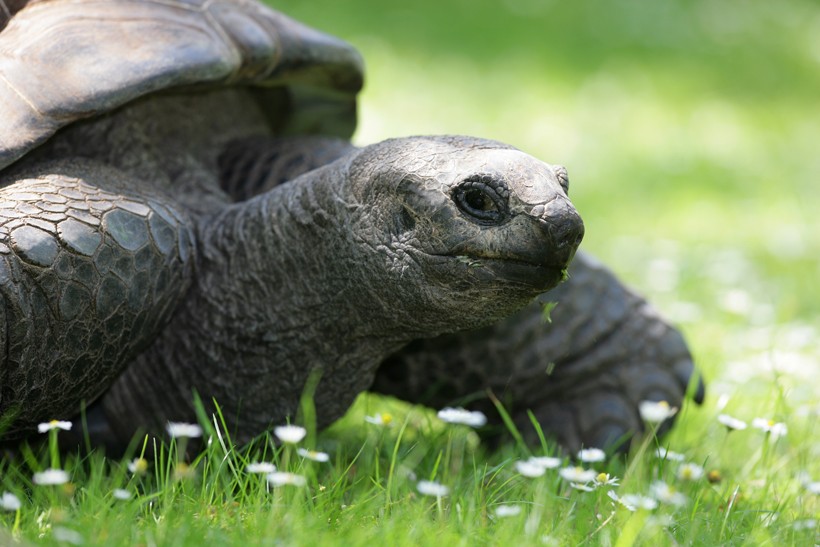
In morning, the turtoise starts looking for food in grasslands
?
Image credits: Holger Ehlers/Shutterstock
Communication
The communication process of the Aldabra Tortoise, whether between individuals or in herds is extremely restricted. The closest the Aldabra comes to social contact, not related to mating, has been observed to be ‘nosing’. This peculiar trait is exhibited when one individual comes up close to another, lies down on the ground and gives the other individual a nose rub on its back or the neck. This ritual may continue for quite some time. Although this trait has been observed in the Aldabra species, no clear explanation is available for this peculiar behavior. It is only during the first rains, that the species migrate towards open and grassy patches and the coastal scrublands.
Population
Although there is no definite data available regarding the exact population of the Aldabra Tortoise, it is estimated that approximately around 100,000 species persist. This population is restricted to the Aldabra Atoll in the island nation of the Seychelles located in the western Indian Ocean. The Seychelles Islands Foundation that comes under the Seychelles National Parks and Conservancy Act, the species has been introduced to conserve this species that has been listed in CITES Appendix II.
Threats
An imminent threat the Aldabra Tortoise faces is the rampant invasion and destruction of its habitat due to human settlements. The introductions of animals that are domesticated have had an adverse effect on its survival and upset the ecological balance in nature.
Animals such as dogs, which prey upon young Aldabra tortoises and goats which graze voraciously on the rich vegetation, have decreased its population. Another impeding cause which poses an even greater threat is illegal pet trade or exotic food trade. Many tortoises are killed or captured and sold as ornamental trinkets that are both cruel and illegal leading to loss of the species population.
Evolutionary History
Resembling some pre-historic animal, the massive Aldabra Tortoise has its origin in Madagascar or the Seychelles. There are two concepts put forward to this view. One view suggests that the tortoise had its origin in Madagascar from where it spread to other areas and the other theory is that it originated in Seychelles and then spread out to other areas, in particular, Madagascar.
Whatever may be the origin of the Aldabra Tortoise, it is estimated that 150 thousand years ago evolutionary expansion of this species took place.
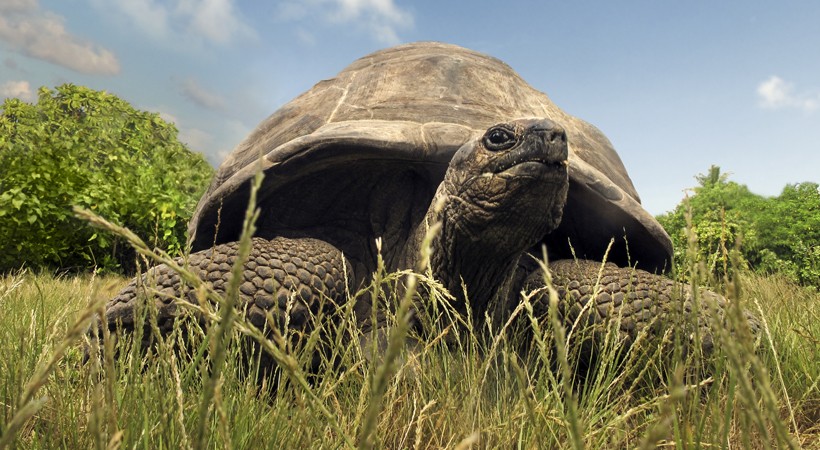
The evolutionary expansion of the Aldabra is estimated on 150 thousand years ago!
?
Image credits: Serge Vero/Shutterstock
Conservation Status
After the extinction of 18 previous other species of this tortoise that had once thrived on the various islands scattered in the Indian Ocean, the Aldabra Tortoise is the lone survivor. The extinction of the other species occurred as sailors extensively hunted them and their soft eggs and young ones were eaten by rodents and domesticated animals. Protective measures towards this tortoise have been initiated to save it from becoming extinct; therefore, it is listed as ‘Vulnerable’ in the Red List of Threatened Species under the IUCN.
Currently, the Aldabra Tortoise reserves a protected status although it hasn’t reached a stage of being endangered.
The Aldabra Atoll in the island nation of Seychelles now has the distinction of being a World Heritage Site and is protected from any form of illegal human interference. This ensures that the largest population of the Aldabra is now safe from any outside influence.
Respective governments have also taken initiatives towards captive breeding which has shown promising results.
Funfacts
- The tiny Aldabra breaks out of its egg shell with the help of a beak-like structure that is already present on the mouth at birth.
- The Aldabra tortoise is also an agent of pollination since it disperses seeds during excretion after they pass through its digestive tract.
- The diet of the young is different from the adults as it stocks up on proteins by eating worms and larvae of various insects.
- The heaviest Aldabra tortoise yet recorded weighs 800 pounds and is present at the Fort Worth Zoo.
- The adult Aldabra can stand on its hind legs to reach out for succulent leaves and shoots that are more than three feet above the ground level.
- The Aldabra tortoise showcases commensalism with a species of hermit crab (Coenobita rugosus) that feeds on tortoise feces.
